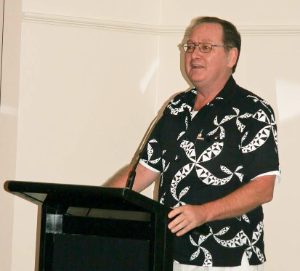 Dr. Russell Howorth told delegates that to reduce risk and vulnerability from disasters confronting Pacific Island countries and territories, a number of important issues must be addressed “in an integrated manner at a national level and supported by regional and international partners.”
Dr. Russell Howorth told delegates that to reduce risk and vulnerability from disasters confronting Pacific Island countries and territories, a number of important issues must be addressed “in an integrated manner at a national level and supported by regional and international partners.”
Dr. Howorth, who is the Director of SOPAC, a Division of SPC, was speaking to more than 200 delegates at the 3rd Session of the Pacific Platform for Disaster Risk Management. The meeting is being held from August 1 thru 5 at the Holiday Inn in Auckland.
He said a critical issue is no matter how climate patterns may change; the impact of hazards must still be managed on a day-to-day basis.
But the key to do so, he said, is to understand the vulnerability and risks before an event happens. “It means to build that knowledge into the decision making process at all levels.”
Dr. Howorth said another key issue is that it is essential that the island countries secure and maintain their natural environments in as healthy and resilient state as possible.
This is to ensure that they can cope not only with the natural hazards of today but also ensure effective protection against potential future hazards including the negative impacts of changes in climate.
Increasing populations and the desire for development has escalated negative impacts in the region. Dr. Howorth said it was essential that land, coastal and ocean resources, (including infrastructure, development and management strategies) can handle further development pressures and impacts.
To achieve this, the latest in information systems (including satellite images) should be introduced into all levels of Government, supported by regional mechanisms.
Finally, Pacific Island countries and territories are faced with increasing infrastructure, responding to globalisation and international trade, including tourism, as part of development in the Pacific.
“They are naturally vulnerable to all of this because of their geographic isolation and small size amidst a vast ocean world forced to contend with these impacts in addition to the everyday day-to-day land, coastal and ocean resource use management problems.
All the impact of these issues can be significantly reduced by an integrated approach.
Dr. Howorth cited examples of some events in the region that have seriously affected development, illustrated the urgency in addressing island vulnerability and risks.
All except the 2010 earthquake in the Solomon Islands, included loss of lives.
• In April 2007 an earthquake and tsunami in the Solomon Islands cost the country an estimated US$90 million, equivalent to 90% of their year’s operating budget.
• In January 2009, flooding in Nadi and Ba, Fiji, cost the country as estimated US$160 million (7% of GDP);
• In September 2009, an earthquake and tsunami in American Samoa, Samoa and Tonga, with Samoa estimated its losses at US$104 million (more than 5% GDP);
• In January 2010 an earthquake and tsunami in the Solomon Islands with costs still to be assessed.
• In recently released 2011 SOPAC/Cook Islands report the costs attributed to 24 cyclones since 1955 is estimated at US$47 million.
In February 2010 Cyclone Pat impacted on Aitutaki damaging 78% of the buildings and devastating local agriculture. The recovery and reconstruction programme is estimated at NZ$9.5 million and this figure does not include estimates for items such as loss of employment or tax revenue
But a recent SOPAC/Vanuatu report illustrated the importance of planning for a risk or hazard.
Vanuatu created a contingency plan that was costed at VT450 million for the possible eruption of an active volcanic island in the north that has been showing increased activity recently.
The plan includes the relocation of all the 2,700 people living on the island and “emphasizes not so much the cost of the disaster, , but the need for easy access to funds should they be required.”
Dr. Howorth said that this was an example of reducing risk and vulnerability from a possible disaster.
Caption: Dr. Russell Howorth during his address.
